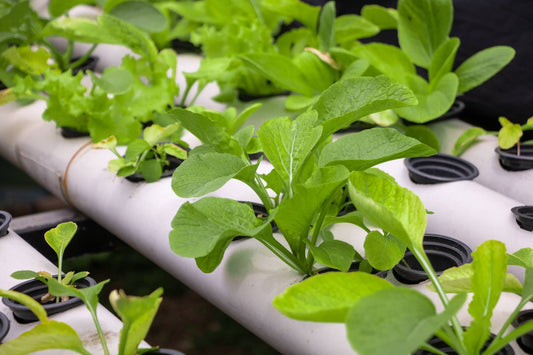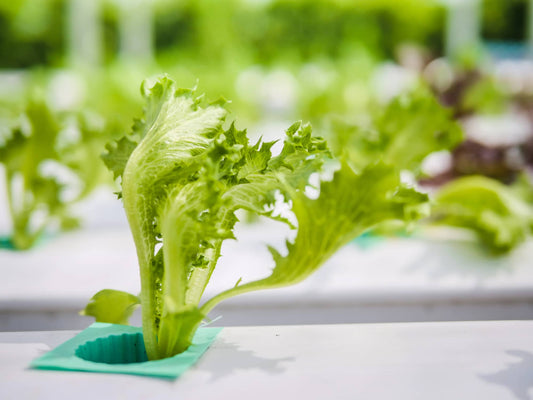Growing tomatoes hydroponically at home is an exciting and rewarding endeavor. It allows you to enjoy fresh, juicy, and flavorful tomatoes year-round, without needing a backyard or even soil. However, tomatoes are large plants—they grow wide, they grow tall, and their roots spread aggressively. To grow them successfully, you must choose the right system, provide adequate space, and cater to their unique needs.
Let’s explore how you can do it the right way!
Choosing the Right Hydroponic System

Before setting up your hydroponic tomatoes, the first thing you need to decide is which& system to use. This decision is crucial because not every hydroponic system can handle the size and strength of a tomato plant. There are three key factors to consider:
1. Root Space – Give Them Room to Grow!
Tomato roots are aggressive. They don’t just grow down; they also spread out wide and can clog small systems that lack sufficient space.
Many hydroponic systems available online, particularly on platforms like Alibaba, have features that may be suitable for smaller plants such as lettuce but are insufficient for tomatoes. If the roots become too crowded, they will obstruct water flow, resulting in poor nutrient absorption and stressing plant health.
What to choose instead?
- Channels with at least 10 cm in diameter and an open cover so you can check and manage the roots.
- Bucket systems (like Dutch buckets), which give each plant its own deep space for roots.
- Any large container system that allows for unrestricted root growth.
2. Tomato Plants Have Big Bodies – Plan for Their Size

If you’ve never grown tomatoes before, you might not realize just how big they can get. Hydroponic tomatoes don’t stay small and compact—they grow tall (up to two or three meters!) and wide, with thick stems and broad leaves.
That means:
- You must give them plenty of space to grow—don’t crowd them!
- They need full sunlight—at least 8-10 hours of direct sunlight per day. If grown indoors, they require strong grow lights for 14-16 hours daily.
- They must be supported—these plants don’t stand on their own. You need a trellis, stakes, or strings to support their weight and prevent them from collapsing.
3. Growing Indoors? Choose the Right Variety

If you plan to grow tomatoes indoors, you need to be extra careful when choosing a variety. Large, vining tomatoes will outgrow your light source and won’t get enough energy to produce fruit properly. The result? Disappointment.
For indoor hydroponics, choose compact, smaller varieties like:
- Cherry tomatoes
- Grape tomatoes
- Other dwarf or bush varieties designed for small spaces
These will stay within the light range and still produce plenty of delicious fruit!
Optimal Growing Conditions for Hydroponic Tomatoes

Once you’ve got the right system and variety, you need to maintain the perfect conditions to help your tomatoes thrive.
- Temperature: 70–85°F (21–29°C) during the day, 60–70°F (15–21°C) at night.
- Humidity: 65–75% during the day, 80–90% at night.
- pH Levels: Keep it between 5.8 – 6.3 for proper nutrient absorption.
-
Nutrients:
- Seedlings: EC of 2.0–2.5 mS/cm for gentle feeding.
- Vegetative Growth: Increase EC to 2.5–3.5 mS/cm to support strong stems and leaves.
- Fruiting Stage: EC should be 3.5–5.0 mS/cm to enhance flower and fruit development.
- Light: Tomatoes need a lot of light! If indoors, ensure they receive a Daily Light Integral (DLI) of 25-30 mol/m²/day, which usually means 14-16 hours under grow lights.
Pollination – How to Help Your Tomatoes Set Fruit
One thing many new hydroponic growers forget is that tomatoes need pollination to produce fruit. Since there are no bees or wind in an indoor hydroponic setup, you have to manually pollinate them.
Here’s how:
- Shake the plant gently to move pollen from flower to flower.
- Use a small fan to create air movement, mimicking wind.
- Use an electric toothbrush or soft brush to transfer pollen between flowers.
Doing this increases fruit production and ensures you get a great harvest.
Pruning Maintenance – Keeping Your Plants Healthy
 Tomato plants require regular maintenance to grow properly and avoid problems.
Tomato plants require regular maintenance to grow properly and avoid problems.
- Trim suckers (small shoots that grow between the main stem and branches) to focus energy on fruit production.
- Support the plant with trellises or stakes to prevent it from falling over.
- Check the roots to prevent overcrowding and blockage in your system.
Pruning is especially important—if you let the plant grow wild, it will produce lots of leaves but fewer fruits.
Growth Timeline – What to Expect
- Germination: 5–20 days
- Seedling to Mature Plant: 20–40 days
- Flowering Fruit Development: 40–60 days
- Harvest: 60–80 days for early varieties, up to 100 days for larger ones
Once they start fruiting, tomatoes can continue producing for several months if cared for properly!
Common Problems Solutions
Even with the best setup, issues can arise. Here’s how to fix some of the most common ones:
1. Blossom End Rot (black, sunken spots on tomatoes)
- Cause: Calcium deficiency, often due to fluctuations in nutrient availability or improper calcium uptake.
-
Solution:
- Keep pH stable (5.8 – 6.3) to ensure proper calcium absorption.
- Add a Cal-Mag supplement to provide extra calcium and magnesium, essential for healthy fruit development.
- Ensure a balanced nutrient solution with steady EC levels to prevent deficiencies.
2. Yellowing Leaves
- Cause: Nutrient imbalance, insufficient oxygenation, or poor air circulation.
-
Solution:
- Check your nutrient mix—ensure essential elements like nitrogen (N), iron (Fe), and magnesium (Mg) are at optimal levels.
- Increase aeration in the root zone by using air stones or increasing oxygen levels in the system.
- Improve airflow around the plants to prevent excess moisture buildup.
3. Leggy Plants (Tall Weak Stems)
- Cause: Insufficient light exposure.
-
Solution:
- Provide 14–16 hours of strong grow light if growing indoors.
- Ensure light intensity is adequate—weak light leads to stretching.
- Use reflective surfaces to maximize light exposure if needed.
4. Poor Fruit Set
- Cause: Lack of pollination or incorrect nutrient balance.
-
Solution:
- Manually pollinate by shaking flowers or using a soft brush/electric toothbrush.
- Ensure proper potassium (K) and phosphorus (P) levels in the nutrient solution to support flowering and fruiting.
Final Thoughts – Growing Hydroponic Tomatoes Like a Pro
Key Takeaways for Success:
- Choose the right system – Give roots enough space (avoid narrow channels!).
- Plan for big plants – They grow tall and wide and need support sun.
- If growing indoors, pick smaller varieties – Keep them within the light range.
- Maintain proper pH, nutrients, and EC levels – Healthy plants = more tomatoes!
- Prune pollinate – More fruit, better air circulation, and a stronger plant.
Ready to Start Growing?
Hydroponic tomatoes taste better, grow faster, and can be harvested year-round—but only if you prepare them for success. By following this guide, you’ll be on track for a plentiful, delicious harvest in no time!
🌱 Happy Growing! 🌱




